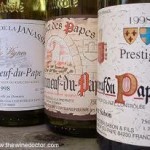We are all creatures of habit and, when we discover those wines that please us, we tend to stick with them.... and stick with them.... and stick with them! Which, of course, makes drinking them about as exciting as watching paint dry.
Hey, there’s nothing wrong with using a “go to” cabernet or chardonnay that is dependable and consistently good when you need a sure thing that works with the meal you are preparing.
And since labels, particularly those affixed to imported wines, require the translation and technical skills of a multi-lingual chemist, it is not difficult to understand why we tend to stick with good wines when we find them. And it’s certainly convenient and prudent to keep a few dependable bottles in the house.
But as one of my wine-stained friends, Guzzler LaMont, once said: “Too much of a good thing is only okay if it’s free and there is a lot of it!”
Well, there may be a lot of ordinary, boring same old, same old out there, but it ain’t free.
My advice is to be adventuresome and try something new each week. Then make a list of the wines you like, why you like them and where they are made. You’ll be shocked and pleasantly surprised by how many really good (and inexpensive) wines there are available if you’ll only give them a try.
Here are a few that demonstrate the diversity, quality and value of wines available right in your own back yard.
2009 Marquis de Riscal Rueda ($12)
An excellent introduction to Verdejo (pronounced vare-day ooh) with bright and refreshing green apple flavors. This Spanish white is crisp and well balanced, and would make a great accompaniment to omelets or brunch type food.
2009 Bodegas Norton Chardonnay ($11)
From Argentina, this golden wine has apple and tropical fruit aromas. Good structure on the palate, round and balanced with a delicate finish. Excellent with roasted cod that is sauced with buerre blanc.
2009 Hahn Winery Monterey Pinot Noir ($15)
This wine showcases the versatility of Monterey County Pinot Noir. With flavors of black cherry and cola , this smooth and balanced wine can be paired with a wide range of dishes. Try it with smoked or grilled salmon, or a roast rack of lamb.
2006 Bodegas Lan Rioja Crianza ($15)
This wine was number 44 on Wine Spectator’s Top 100 list of 2010.
From the Rioja region of northern Spain, this fresh and balanced red brims with cherry, spice and licorice. The texture is generous yet delicate.
Made from 100 percent Tempranillo, the wine begs to be paired with grilled flank steak.





